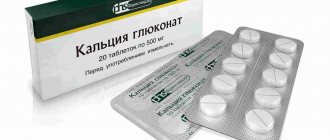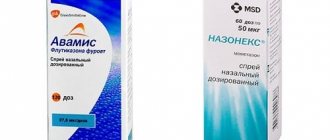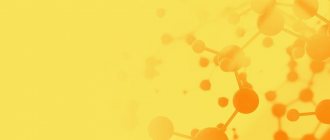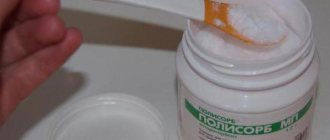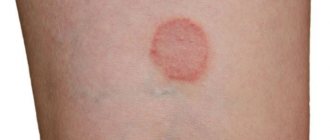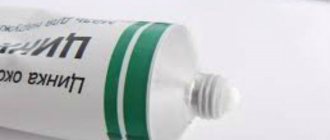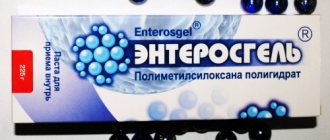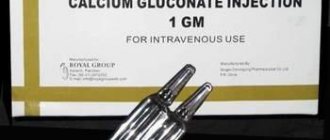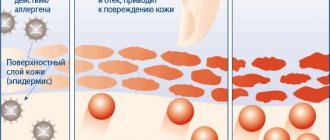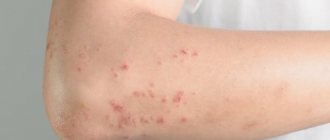Characteristics of the medication
Nasonex spray belongs to the category of hormonal drugs.
Made in Belgium. Sold in a bottle made of durable plastic with a dispenser for approximately 120 - 140 doses. Nasonex has positive reviews from specialists and patients. It relieves symptoms of diseases well, and is especially effective in combating nasal congestion.
Anna R. Ryazan: I suffered from allergic symptoms all year round. Runny nose, lacrimation, did not go away. Doctors prescribed many medications. Some helped, some brought temporary relief. There was no obvious positive result. When I switched to Nasonex I felt better. The nasal congestion went away quickly, the other symptoms a little later. I like the medicine and will continue to take it, despite the high price. I don’t want to use similar means, I’m afraid the effect will disappear.
Yuri M. Kazan: Runny nose and nasal congestion were constant signs of spring and autumn. He was treated with many medications. I've heard both good and bad reviews about Nasonex. Many people are afraid that it is hormonal. But with my runny nose, I took so many antibiotics that spraying hormones into my nose doesn’t seem so scary anymore.
Svetlana Alekseeva Tuapse: I had vasomotor rhinitis for a long time. I constantly used vasoconstrictor drops, without them it was not possible to live even one day, or sleep one night. With such swelling of the mucous membrane, some doctors suggested surgery, but they said that this was still not a solution. The swelling will still continue.
Composition and release form
Each dose of Nasonex contains 50 mcg of mometasone furoate in the form of monohydrate, the substance is an active GCS (glucocorticosteroid).
The composition contains as auxiliary ingredients:
- dispersed cellulose;
- glycerol;
- sodium citrate dihydrate;
- distilled water;
- citric acid hydrate;
- phenylethyl alcohol.
The bottle has a plastic dosing valve. There is no children's release form, so the dosage is selected taking into account the patient's age.
The principle of action of the drug
Nasonex is prescribed to children for rhinitis of various natures, chronic inflammation of the nasal cavity, sinusitis, sinusitis and adenoiditis. Like any hormonal drug, it must be used extremely carefully, only as prescribed by a doctor. The common cold is not an indication for the use of this medication.
The active substance of the pharmaceutical drug is an artificial corticosteroid - mometasone furoate. It is a substitute for human adrenal hormone.
It also contains an antiseptic - benzalkonium chloride, and a decongestant - glycerol. The triple effect gives a pronounced therapeutic result: blood supply is normalized, swelling disappears, and mucus formation is reduced. The antihistamine effect lasts a day after taking a dose of Nasonex.
Release form: spray for injection into the nose. A single press on the plastic bottle dispenser releases 50 mcg of the active ingredient. Vials are usually designed for 60 or 120 doses. It is incorrect to call the product the term “drops”, because simple instillation without spraying is prohibited. It is injection that ensures uniform dispersion of the hormonal medication, which allows you to achieve maximum effectiveness and avoid overdose.
When used correctly, the drug is safe: the corticosteroid does not penetrate into the blood and will only affect the affected areas of the nasopharynx.
Therapeutic effect
Nasonex has the following effects:
- Antipruritic;
- Antiallergic;
- Anti-inflammatory;
- Vasoconstrictor.
Nasonex spray, according to the instructions for use, has a noticeable effect on the lining of the nasopharynx. It also has a vasoconstrictor effect on the vessels of the sinuses. As a result, swelling decreases and inflammation of the tissues of the nasal cavities decreases.
Symptoms are relieved and the patient’s well-being improves. During a course of treatment with a spray, relapses occur less frequently than when using other medications of the same category.
During medical tests, the spray was found to be highly effective in relieving allergies. For allergic rhinitis, the therapeutic effect occurs 12 hours after using the medication. Increased lacrimation, burning and redness of the eyes quickly disappear. Nasonex can be used to get rid of polyps and normalize the sense of smell. He copes with these problems effectively.
Use for allergies
Nasonex spray is a classic steroid for intranasal use. Refers to active hormonal drugs. Contains a safe concentration of corticosteroids - the bioavailability of mometasone when applied topically as a spray is only 0.1%, which reduces the risk of developing serious side complications.
The product is available only in the form of a spray with a volume of 60 or 120 doses.
Nasonex has a powerful anti-inflammatory and persistent antiallergic effect. Clinical studies of the drug have proven that the active hormone in the composition is able to reduce swelling and nasal congestion during allergies, both in the early and late stages.
The drug demonstrates a positive effect on respiratory tract reactions. Symptoms typical of allergies are reduced - congestion, tearing, itching and burning. The product is effective in the treatment of already manifested allergies, in contrast to antihistamine nasal sprays.
We also recommend that you read the material on how to treat allergic rhinitis during pregnancy at this link.
Depending on the characteristics of the therapy, the drug may cause various side effects during the treatment period. For allergic rhinitis in adults and children, the following reactions are possible:
- headache;
- pharyngitis;
- burning sensation, dryness in the nose;
- sneezing.
Find out how to stop nosebleeds here.
Epistaxis during treatment with hormonal sprays is a typical reaction of the body to the active substance. They are usually not severe and go away on their own in a short period of time. When treating sinusitis with Nasonex, irritation of the mucous membrane may occur. If such a sign is detected, the drug should be stopped.
It is not recommended to use Nasonex simultaneously with other glucocorticosteroid drugs, regardless of the form of release. This contributes to the inhibition of the functioning of the endocrine glands (hypothalamus, pituitary gland and adrenal glands). Overdose of hormonal drugs and prolonged therapy leads to disruption of metabolic processes in the body and the development of systemic autoimmune diseases.
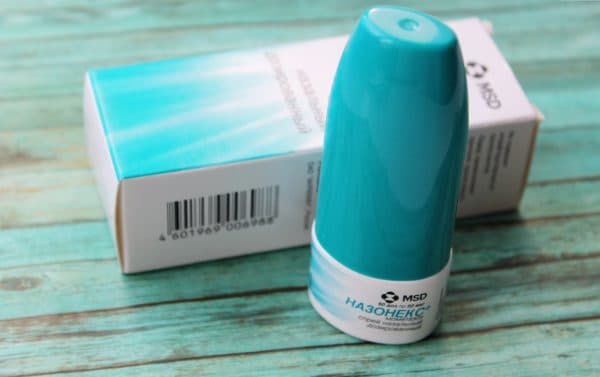
The drug should be taken with caution together with vasoconstrictors for topical use, because they increase dryness and irritation of the nasal mucosa.
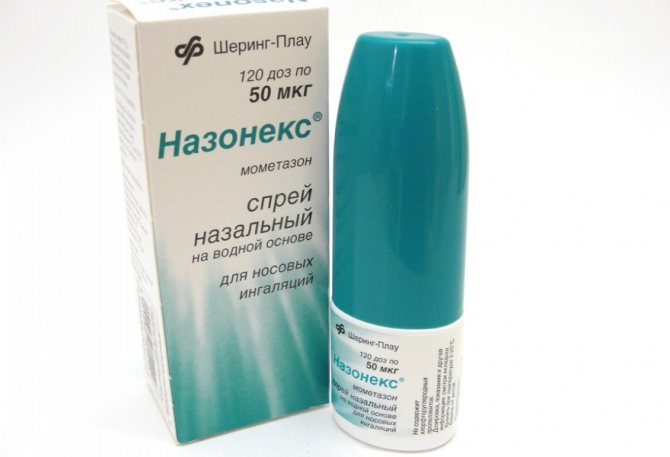
Nasonex according to the instructions is used in the treatment and prevention of rhinitis, which can last all year round or be observed only in the off-season. In these cases, two doses, that is, sprays, will be prescribed per day for each nostril. When improvement occurs, the dose of Nasonex is reduced.
If the appearance of pathology does not go away, then the number of injections is increased, but the maximum dosage (400 mg - 4 injections) cannot be exceeded. For children over two years old, one injection is prescribed for each nasal passage once a day. The instructions for use do not recommend exceeding the dosage of Nasonex.
Pharmacological properties
Pharmacodynamics
Mometasone furoate is a glucocorticosteroid for topical use, which, when used in doses that do not cause systemic effects, has anti-inflammatory and antiallergic effects.
Nasonex prevents the marginal accumulation of neutrophils, due to which the inflammatory exudate and the production of lymphokines are reduced, the migration of macrophages is inhibited, and the processes of infiltration and granulation are reduced.
Mometasone inhibits the release of inflammatory mediators from mast cells. Increases the production of lipomodulin, an inhibitor of phospholipase A, resulting in a decrease in the release of arachidonic acid and, as a result, the synthesis of its metabolic products - prostaglandins and cyclic endoperoxides - is inhibited. These properties determine Nasonex's ability to inhibit the development of an immediate allergic reaction. By reducing the formation of chemotaxis substance (impact on late allergy reactions), the drug reduces inflammation.
In studies with provocative tests in which antigens were applied to the mucous membrane of the nasal cavity, the high anti-inflammatory effectiveness of mometasone was established in the early and late stages of the allergic reaction. This effect was confirmed by a decrease (compared to placebo) in eosinophil activity and histamine concentration, and a decrease (compared to baseline) in the number of neutrophils, eosinophils and epithelial cell adhesion proteins.
Pharmacokinetics
The systemic bioavailability of mometasone furoate when administered intranasally does not exceed 1% (with a sensitivity of the determination method of 0.25 pg/ml).
Mometasone is very poorly absorbed from the gastrointestinal tract. A small amount of the drug that can enter here after administration into the nasal cavity undergoes active metabolism during the first passage through the liver and is excreted in bile and urine.
Main Application
The wide influence of the active substance on the body allows it to be used for various manifestations of allergies and inflammation. Nasonex according to the instructions is used for the following diseases:
- Allergic rhinitis, which manifests itself in the off-season and all year round;
- For the prevention of severe and moderate forms of seasonal allergic rhinitis;
- Polyps of the nasal sinuses and passages, which, when growing, interfere with nasal breathing;
- Chronic sinusitis during exacerbation;
The spray showed good effectiveness in the treatment of prolonged inflammation of the nasal passages. Nasonex is often used in complex treatment of nasopharynx with other medications. The drug effectively reduces nasal congestion in many pathologies.
Indications and contraindications for taking Nasonex drops (spray)
The spray is prescribed for the treatment of allergies and inflammation of the nasal mucosa of various etiologies. The main indications for use are:
- Continuous long-term allergic rhinitis. It can last for more than a year. The drug is effective in eliminating any symptoms of allergic rhinitis.
- Subacute or acute sinusitis. The drug is used in combination with other drugs.
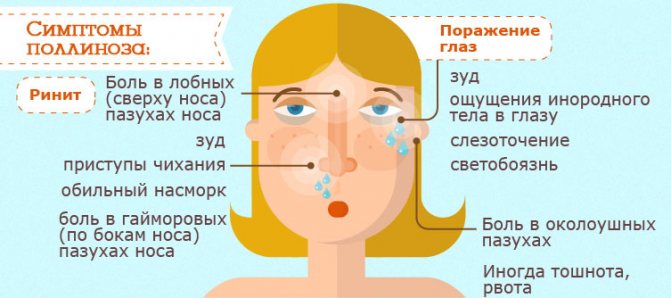
Hay fever (allergic rhinoconjunctivitis). This is an inflammation of the nasal mucosa, as well as the eyes. Manifests itself as a result of seasonal allergies.- Polyps formed in the nasal passages. These are benign formations that arise on the walls of the nasal cavity.
- Prevention of runny nose caused by allergies to pollen. In this case, the solution begins to be used in advance, a month before the start of the plant flowering process.
Nasonex is contraindicated:
- in case of developing an allergy to any of its components,
- with infectious lesions of the nasal mucosa,
- in the presence of unhealed postoperative wounds,
- when identifying tuberculosis pathogens in the respiratory tract. In case of urgent need, the drug can be prescribed, but strictly under the supervision of a specialist,
- for rhinitis and sinusitis that develop as a result of viral, bacterial or fungal infection.
At the same time, you should absolutely not use the drug yourself if there are complications in the form of damage to the membranes of the eyes. Treatment of such pathologies is performed in a hospital setting.
This medicine is extremely rarely prescribed for inflammatory processes in the nasopharynx in pregnant women due to the lack of clinical trials.
It is not known for certain how the drug affects the health of the fetus. During seasonal exacerbations of rhinitis, Nasonex is also not prescribed to expectant mothers. There are many other non-hormonal and safe means for this.
Restrictions on use
According to reviews from patients and specialists, the use of Nasonex is effective. But its use is subject to limitations.
The use of the spray is contraindicated for the following diseases and conditions:
- Personal intolerance to the ingredients of the medication;
- Infection in the nasal mucosa;
- Age restrictions;
- Recent surgery or trauma to the nose with disruption of the nasal mucosa (after healing, the spray is used).
In special cases, Nasonex spray is prescribed for tuberculosis, an untreated infection with eye damage.
No special studies have been conducted, so it is difficult to definitively answer whether Nasonex can be used while carrying a child and feeding him breast milk. The use of the drug intranasally (through the nose) does not allow the main components to enter the circulatory system. If you do not exceed the therapeutic dosage, no harm will be caused to the body.
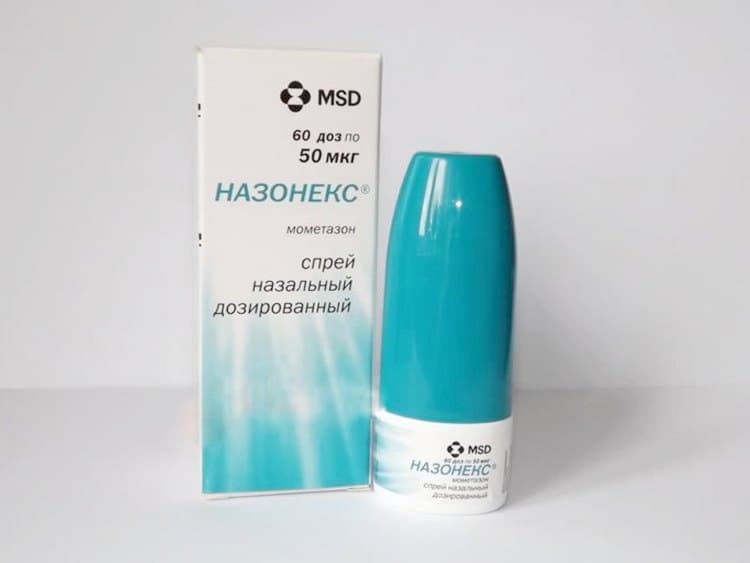
But Nasonex is a glucocorticosteroid, that is, a hormonal medication. Its effect on a woman’s body when carrying a child and breastfeeding it can be unpredictable; it is better to eliminate any risk at this time. If a woman took hormonal medications while expecting a baby, then newborn babies must be examined for early detection of adrenal hypofunction.
Side effects of nasal spray
The spray is prescribed by the attending physician; independent use of hormonal drugs is strictly not recommended due to the high likelihood of side effects. Nasonex is used:
- for the treatment of seasonal and year-round allergic rhinitis for adults and children over 2 years old;
- as part of the treatment of drug-induced, vasomotor rhinitis during an exacerbation in adults and adolescents. Also suitable for the treatment of chronic vasomotor rhinitis.
- as part of complex therapy for sinusitis (usually in the form of sinusitis) for adults, children over 12 years of age;
- as a preventive measure for the development of hay fever 2-4 weeks before the start of the pollination season.
Find detailed information about treating vasomotor rhinitis at home here.
The drug has many contraindications; before the first dose, you should carefully study the instructions for use. The main ones:
- hypersensitivity to any component of the composition;
- inflammatory and infectious process in the respiratory system;
- postoperative period;
- tuberculosis;
- age up to 2 years.
Nasonex is acceptable for use during pregnancy and lactation, since when administered intranasally, the hormone is practically not absorbed into the intestines or blood plasma. There is no reliable data on the potential harm of the drug to the fetus, so the spray should be used with caution. However, doctors do not recommend taking any hormonal drugs in the 1st and 2nd trimester.
Overdose
In case of long-term use of Nasonex in high doses or simultaneous use of other corticosteroids, the risk of suppression of the hypothalamic-pituitary-adrenal system increases.
Given the low systemic bioavailability of mometasone furoate when administered intranasally, it is unlikely that in case of overdose, special medical measures will be required, other than monitoring the patient's condition. In the future, the use of Nasonex can be resumed at the recommended dose.
Manifestation of adverse reactions
Negative manifestations occur when the dosage is exceeded or the body is intolerant to the medication. In case of severe adverse reactions, a replacement for Nasonex is selected. In most cases, the drug is well tolerated, all manifestations are temporary and go away on their own without medical help.
Negative manifestations in adult patients:
- Nosebleeds;
- Pharyngitis;
- Burning in the throat and nasal passages;
- Irritation of the nasopharyngeal mucosa.
Children more often complain of itching, burning in the nasopharynx, increased sneezing, and pain in the head. In exceptional cases, hormonal medications increase intraocular pressure or perforation of the nasal septum occurs.
Use of drops in children
Pediatricians prescribe Nasonex to children for seasonal and year-round runny nose of an allergic nature. The drug is also prescribed for diseases such as sinusitis and rhinosinusitis. For these pathologies, the spray is used in combination with other medications, for example, antibiotics. Nasonex is often used for preventive purposes in adolescents.
The indications for use of the drug do not include such a disease as inflammation of the adenoids, however, the drug is often prescribed for this pathology for children over two years of age. Nasonex should be used for adenoiditis only as prescribed by an ENT doctor.
It is possible to understand that a child has adenoids by the following symptoms:
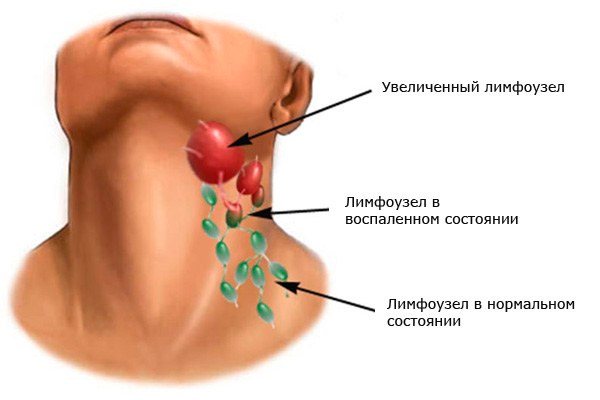
heavy breathing during the day and sleeping with your mouth open,- constant nasal congestion with mucus (snot),
- disturbed sleep with periodic awakenings,
- changed voice timbre,
- enlarged lymph nodes, general weakness,
- slightly elevated body temperature,
- dry cough.
If a child has such symptoms, this may indicate grade 1-2 adenoids. In this case, it is necessary to consult with a specialist who will determine whether Nasonex spray should be used and in what dosages.
Usually 50 mcg is prescribed. This is a single dose sprayed into one nostril. For children from two to twelve years of age, the recommended daily dose is 100 mcg, that is, one injection into each passage.
Important! The drug is contraindicated for children under two years of age. The medication for sinusitis cannot be used until the age of twelve. In addition, Nasonex is contraindicated in case of intolerance to one of the components of the drug and after injuries, as well as emergency interventions in the nasopharynx.
In children, adverse reactions may be the same as in adults, but they are more intense. Additionally, children may experience cough and bronchospasm. Sometimes breathing problems are possible; this condition manifests itself as shortness of breath. In more rare cases, the sense of smell and acuity of taste buds decreases.
There have been cases of allergic reactions to the drug. In this case, patients experienced Quincke's edema and anaphylaxis with suffocation, muscle spasms and sharp pain in the head.
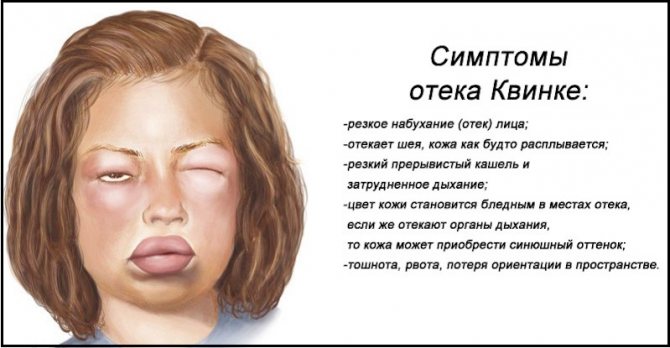
Quincke's edema
Medicines are prescribed with extreme caution for tuberculosis and other infections of a bacterial and fungal nature. For such diseases, the drug should be used under close medical supervision.
Patients who use the spray for a long time (more than a month) should be periodically examined by a doctor to prevent the development of changes in the mucosa. If a specialist detects the presence of a fungal infection, then it is necessary to stop using the medication and treat it. The drug is also discontinued in case of irritation of the mucous membrane.
Instructions: method of use and dosage
Before you start using Nasonex, the instructions for use explain how to calibrate. It is needed to determine the standard delivery of the suspension to the mucous membrane. To do this, press the bottle dispenser ten times, calibration will occur automatically. If this bottle does not work for more than two weeks, then another calibration will need to be done.
The bottle is shaken before each injection, and the nasal passages are cleared of congestion. Then the active substance of Nasonex will act directly on the problem area. If the nozzle becomes clogged from constant use, you must disassemble the dispenser according to the instructions. Rinse and dry the removable parts and reassemble.
According to the instructions, Nasonex is used intranasally. Injections are carried out using a dispenser on the bottle, alternately into each nasal passage.
| Age | Dosage (how much to drip) |
| Children from 2 to 11 years old | 1 inhalation into each nasal passage 1 time per day, maximum daily dose – 100 mcg. |
| Children from 11 years old, adults | During the period of exacerbation - 2 injections into each nasal passage 1 time per day; during recovery with maintenance treatment, the dosage is halved. The maximum dose is 200 mcg. |
Before first use, you should configure the dispenser. To do this, you need to press the nozzle 6-7 times, due to which the same type of drug delivery is achieved. If treatment is necessary after a long break, the procedure can be repeated.
Nasonex for snoring
According to most studies, snoring most often occurs in people with chronic rhinitis. Over time, a relationship has emerged between the use of the spray and improved quality of sleep and breathing at night. Nasonex for snoring is used quite widely, but the manufacturer did not intend such an effect from the drug.
According to reviews of Nasonex for snoring, one can judge the effective results of the drug with regular preventive use. Also, in 2004, a large-scale study was conducted that revealed a stable decrease in snoring in subjects who used the drug against the background of rhinitis, apnea, and allergies. The recommended dose to eliminate snoring is 200 mcg per day, you need to irrigate the nasopharynx once.

Another important aspect is eliminating snoring in children with Nasonex. The product can be used starting from 2 years of age.
Over time, the drug began to be prescribed by doctors to patients with complaints of nighttime snoring. Now Nasonex is one of the most common remedies in the fight against snoring.
To prevent snoring, Nasonex can be used for a long period (up to 1 year) in a small dosage.
Features of therapy
The use of Nasonex spray for more than 1 year can lead to irreparable changes in the mucous membrane of the nasopharynx. To exclude such tissue disorders, patients should visit an otolaryngologist for a preventive examination. Also, the ENT doctor will be able to detect a fungal infection in the nose, which will be invisible to the person. In this case, stop using Nasonex spray.
In case of prolonged irritation of the mucous membrane from the use of Nasonex, analogues are prescribed.
If patients had previously used hormonal drugs and then began to use Nasonex, they should be monitored for the development of a deficiency in the functioning of the adrenal cortex. With the abolition of hormonal drugs, there is a risk of symptoms of conjunctivitis and allergic eczema. These pathologies have been present in the body for a long time, their development was restrained by the hormonal medications used.
Doctors should warn that the use of hormonal drugs sharply reduces immunity. Contact with infectious patients (especially chickenpox) increases the risk of infection. During seasonal illnesses, increased safety measures must be taken.
special instructions
When Nasonex was used for 12 months, no signs of atrophy of the nasal mucosa were detected. Moreover, the nasal spray contributed to the normalization of the histological picture when examining a biopsy of the nasal mucosa. However, with long-term (several months or more) use of Nasonex, patients should undergo regular examinations with a doctor in order to promptly identify changes in the nasal mucosa, if any develop.
Signs of suppression of the function of the hypothalamic-pituitary-adrenal system were not observed during long-term treatment. Patients who are transferred to Nasonex after long-term therapy with systemic corticosteroids should be under special supervision, since their withdrawal can lead to the development of adrenal insufficiency. If signs of adrenal insufficiency appear, it is necessary to resume taking systemic corticosteroids and, if necessary, take other therapeutic measures.
Patients switching to Nasonex from systemic corticosteroids may develop initial withdrawal symptoms (fatigue, depression, muscle and/or joint pain), despite a decrease in symptoms associated with damage to the nasal mucosa. The use of Nasonex in this case must be continued. When switching to intranasal therapy, the manifestation of pre-existing allergic diseases, but masked by systemic corticosteroids, is also possible, for example, eczema or allergic conjunctivitis.
In children, GCS can cause growth retardation. In this case, it is necessary to reduce the dose of Nasonex to the minimum that can control the symptoms of the disease. Consultation with a pediatrician is required.
In case of development of a local fungal infection of the nose/pharynx, appropriate treatment is required and, probably, discontinuation of Nasonex is required. Discontinuation of drug therapy may also be necessary if irritation of the nasal/pharyngeal mucosa persists for a long time.
Patients receiving corticosteroids have a potentially reduced immune reactivity, so they have an increased risk of infection through contact with patients with certain infectious diseases (for example, measles or chickenpox). Such patients should be warned about the necessary precautions. If contact occurs, it is recommended to consult a doctor. Immediate medical consultation is required if signs of severe bacterial infection appear, such as fever, persistent and sharp toothache or pain on one side of the face, swelling in the periorbital/orbital area.
Nasonex, like other intranasal corticosteroids, may cause the development of systemic side effects, especially when used in high doses for a long time, although this risk is significantly less than the use of oral corticosteroids. Symptoms may vary depending on the type of drug used and the individual sensitivity of the patient. Potential systemic effects include: characteristic signs of Cushingoid, Cushing's syndrome, growth retardation in children and adolescents, adrenal suppression, glaucoma, cataracts, and less commonly, behavioral and psychological effects, including sleep disturbance, psychomotor hyperactivity, anxiety, depression , aggression (especially in children).
The safety and effectiveness of mometasone for polyps that completely occlude the nasal cavity, polyps associated with cystic fibrosis, and unilateral polyps have not been studied. If unilateral polyps of irregular or unusual shape are detected, especially those that are ulcerated and/or bleeding, additional medical examination is required.
Impact on the ability to drive vehicles and complex mechanisms
There are no data on the effect of Nasonex components on cognitive, mental and motor functions in humans.
Drugs - analogues
If it is impossible to use Nasonex, the doctor prescribes analogues. They are cheaper, but have the same composition. The following medications can replace the spray:
- Desrinitis. Relieves nasal congestion, swelling of the nasopharynx, helps with allergic rhinitis. It is a hormonal agent. Approximate price 400 rubles.
- Avamis. A hormonal remedy that helps reduce the symptoms of allergies and sinusitis. Prescribed for the treatment of polyps. Easily tolerated, has few restrictions. The price starts from 500 rubles.
- Flixonase. Produced in Poland. Effectively helps with nasal congestion of various origins. It relieves swelling of the nasopharyngeal mucosa well, reduces tissue inflammation during prolonged colds. Has few restrictions for use. Price from 430 rubles.
Analogs to Nazonex are selected only by a doctor. It will take into account the characteristics of the body, the presence of chronic diseases, and the possibility of developing complications. It is difficult to say which drugs are better - Nasonex or Avamis or other drugs. Often the choice depends on the individual characteristics of the patient’s body, especially for children. Self-medication and independent drug replacement are not allowed.
This drug is not cheap. The average market price of Nasonex spray for 120 doses is 840 rubles, 60 doses can cost 490 rubles. There are not many drugs on sale for the treatment of allergic and vasomotor rhinitis, sinusitis with mometasone as an active substance. The most accessible analogues (replacement) in the form of a spray are Dezrinit (Israel), Avamis, Nosephrin, Momat Rino, Asmanex Twistheiler (USA).
Also, for the treatment of allergic rhinitis, doctors recommend using the Erius remedy, which this article will talk about.
